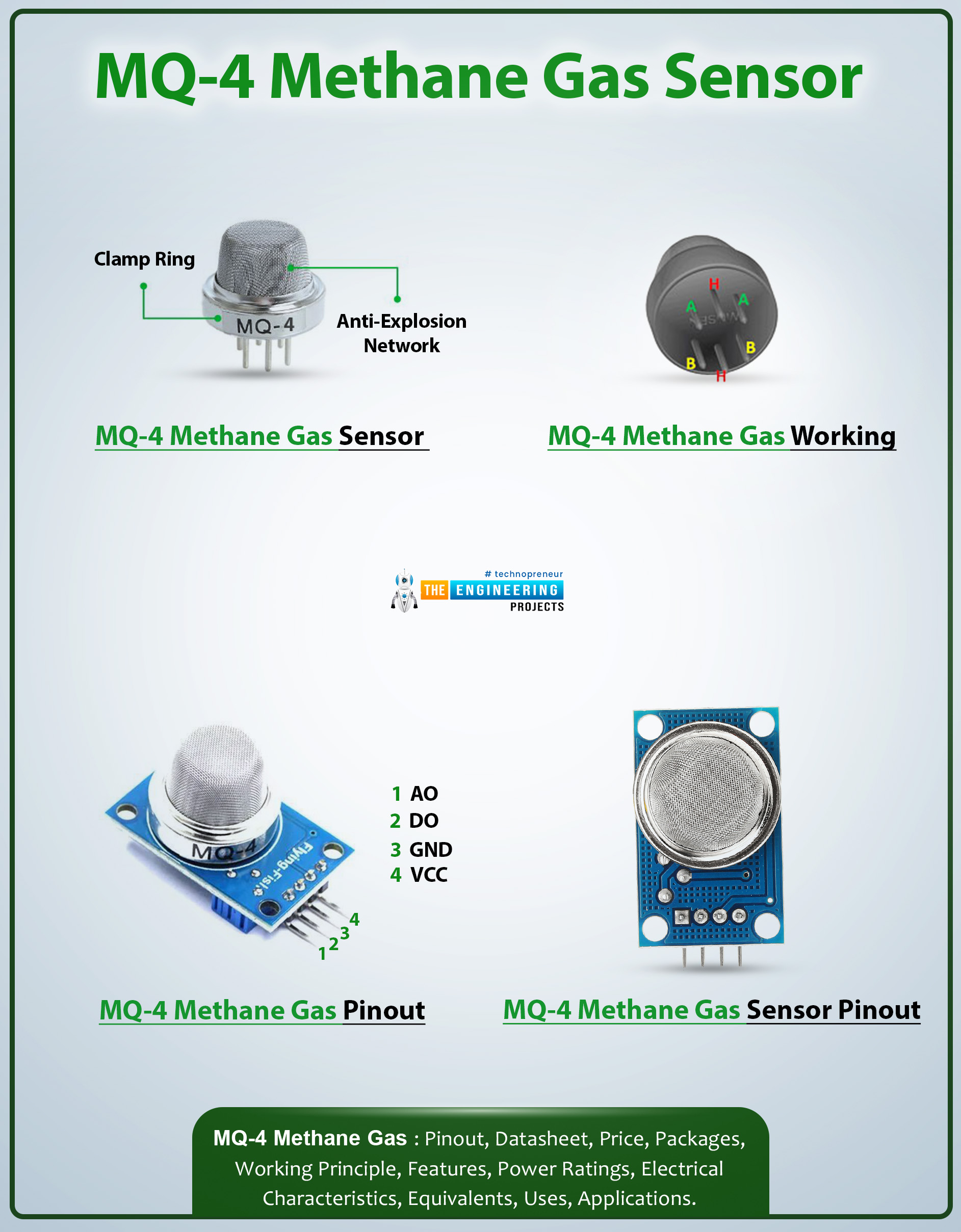
Hello readers! I hope you are doing great. Today we are discussing the features and details of the MQ-4 methane gas sensor, which belongs to the popular gas sensor MQ family. We have been working on other gas sensors as well, but MQ-4 is particularly suitable for detecting the presence of methane gas. This sensor is more popular because methane gas and compressed natural gas (CNG) are widely used for cooking and other related purposes. MQ-4 methane gas sensor is an important part of the home safety system. Some other advantages of this sensor are, that it responds instantly and has a potentiometer that adds versatility to its functions.
In this article, we are going to study the MQ-4 methane sensor from scratch. We’ll go through its introduction and will study the basic components of its datasheet. We’ll see some performance graphs and study the internal structure of this sensor. After that, we’ll move towards the external circuit and its working features. In the end, there will be a study of its applications. This is going to be an easy and informative article, so let’s move on to the first point:
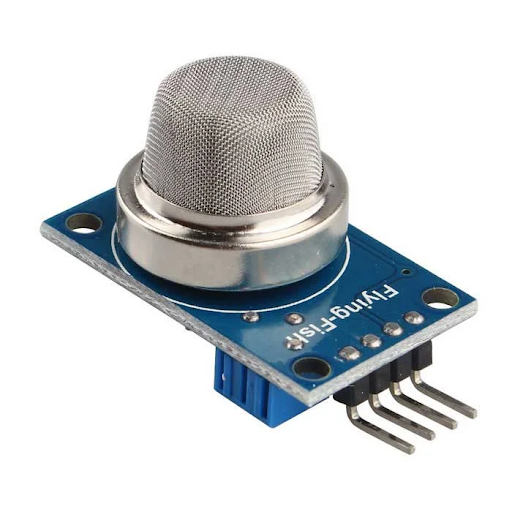
MQ-4 Methane Gas Sensor Introduction
Methane gas is widely used everywhere, and we’ve seen multiple cases of gas leakage. Therefore, the MQ-4 methane gas sensor has a special place in different applications in almost every domain of life. The MQ-4 methane gas sensor is a metal oxide semiconductor (MOS) that detects the presence of methane gases and then provides the result in the form of analog values. In this way, it provides information about the gas concentration, and its range is 300 ppm–10,000 ppm which is enough to detect leakage.
The basic structure of this gas sensor includes the following:
- A double mesh network
- Detecting element
- Pins
- Firm base
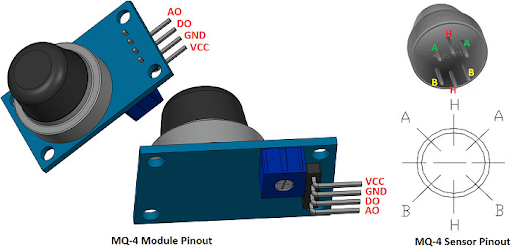
The sensitivity of this detector for different gases may vary but overall, it is a good choice for detecting any gas leakage. This sensor can detect gases like:
- Methane (CH4)
- Ethanol (C2H5OH)
- Liquefied petroleum gas (LPG)
- Benzene (C6H6)
- Smoke
The ignition of these gases is extremely exothermal, so these produce a large amount of what. Therefore, the MQ-4 methane sensor is a life-saving element.
MQ-4 Methane Gas Sensor Datasheet
Till now, we have seen the basic features of this sensor but now, we are going to discuss the details of its functions. Here are some important points that will highlight the importance of this sensor:
- The primary function of the sensor is to detect methane (CH4 ) gas. It is highly sensitive to methane and other natural gases; therefore, it is widely used to detect gas leakage.
- It has some sensitivity for gases like ethanol (C2H5OH) but is not an ideal choice for it. For the best precision of such gases, the MQ-3 alcohol sensor is used.
- Another gas that MQ-4 can detect is liquefied petroleum gas (LPG). It also includes propane (C3H8) and butane (C4H10).
- Other gases detected by this sensor are benzene (C6H6), which is an aromatic hydrocarbon with potential health risks, and smoke (which may trigger incomplete combustion products).
- This sensor has a fast response time with a very small recovery time.
- It has a long life, and it provides suitable performance all the time.
- It has a compact size and an easy-to-integrate design.
MQ-4 Methane Gas Sensor Specifications
There are multiple types of specifications, and I’ve divided them into different groups for clarification. Here is the table that shows the standard work condition parameters and their details:
Parameter |
Technical condition |
Circuit voltage (Vc) |
5V ± 0.1 |
Heating voltage (VH) |
5V ± 0.1 |
Load resistance (PL) |
20 kΩ |
Heater resistance (RH) |
33 Ω ± 5% |
Heating consumption (PH) |
Less than 750 mW |
Now, here are some important environmental parameters for the MQ-4 methane sensor:
Parameter |
Symbol |
Value |
Using Temperature |
Tao |
-10℃ - 50℃ |
Storage Temperature |
Tas |
-20℃ - 70℃ |
Related Humidity |
RH |
Less than 95%Rh |
Oxygen Concentration |
O2 |
21% (standard condition) |
The sensitivity characteristics of this sensor, along with important parameters, are given below:
Parameter |
Symbol |
Value |
Sensing Resistance |
Rs |
10KΩ - 60KΩ |
Concentration Slope Rate |
α |
≤ 0.6 |
Temperature |
- |
20℃ ± 2℃ |
Circuit Voltage |
Vc |
5V ± 0.1 |
Humidity |
- |
65% ± 5% |
Heating Voltage |
Vh |
5V ± 0.1 |
Preheat Time |
- |
Over 24 hours |
MQ-4 Methane Gas Sensor Structure
The internal structure of the MQ-4 methane sensor is similar to that of its other daily members. Here is the detailed internal structure diagram that will help you understand the information we’ll discuss in the next section:
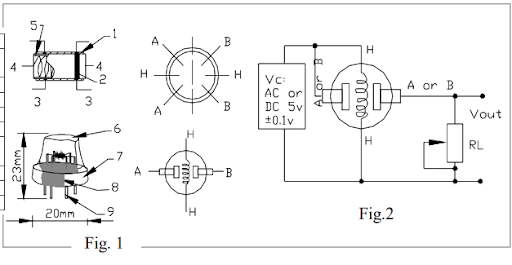
As discussed before, the MQ-4 methane sensor has different sensitivity levels for different gases. Based on multiple experiments, here is the graph that describes the sensitivity results:
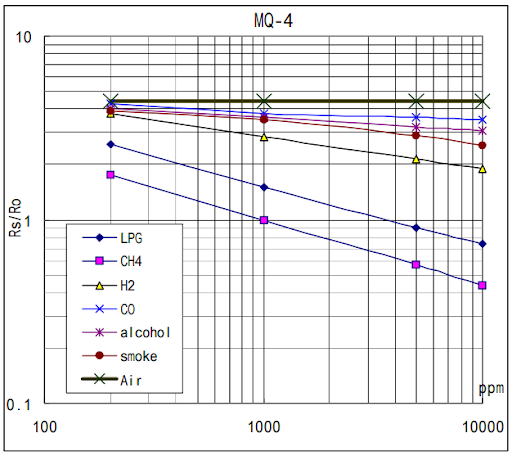
The temperature and humidity around the MQ-4 methane sensor play a crucial role in the performance scale. Here is the graph that shows the change in the sensor’s behavior with varying temperatures and humidity:

Here,
Rs = The sensing resistance that depends on the concentration of the target gas. In the case of MQ-4, the target gas is methane.
R0 = The resistance of the sensor in clean air. It is the baseline resistance of the sensor when there is no methane present in the air.
Rs/R0 = It is the ratio of sensing resistance to the resistance in clean air. It is calculated to understand the relative change in the resistance of the sensor, and it depends on the target gas concentration.
If you want to see the detailed datasheet of the MQ-4 methane gas sensor, then you can visit the link MQ-4 Methane Gas Sensor.
MQ-4 Methane Gas Sensor Pinout Configuration
Now, it is time to discuss the external structure of this sensor. Just like most of the members of the MQ sensors, this sensor has four pins. The name of each pin and its function are given in the table below:
Pin Name |
Description |
VCC |
This pin powers the module and typically has an operating voltage of +5 volts. |
GND |
This pin is used to connect the module to the system's ground terminal |
Digital Out (DO) |
This pin is used to get digital output from the sensor. It is done by setting a threshold value using the potentiometer of the sensor. |
Analog Out (AO) |
This pin outputs 0-5V analog voltage, which is based on the intensity of the gas |
MQ-4 Methane Gas Sensor Packages
For the convenience of the user, the MQ-4 methane sensor comes in different packages. Here is the table that will show a brief introduction to the available packages:
Feature |
DIP |
SMD |
TO-220 |
Custom Module |
Package type |
Through-hole |
Surface mount |
Through-hole |
Encapsulated module |
Size |
Large |
Small |
Large |
Varies by module |
Ease of use |
Easy (breadboard compatible) |
Requires soldering & reflow oven |
Moderate (soldering) |
Easy (plug-and-play) |
Power requirements |
Low |
Lower than TO-220 |
Highest |
Varies by module |
Additional circuitry |
Requires external circuit |
Integrated circuit |
Integrated circuit |
Varies by module (may include voltage regulation, communication) |
Applications |
Hobby projects, prototyping |
Commercial electronics, space-constrained designs |
Industrial gas detection |
Beginner projects, quick integration |
Considerations |
Limited space for additional components |
Requires soldering expertise |
Larger size, higher power draw |
May lack specific features |
MQ-4 Methane Gas Sensor Alternatives
Here is a list of some other alternatives that are used in place of the MQ-4 methane gas sensor, along with the types of gases these can sense:
- Electrochemical sensors
- Photoionization detectors (PIDs)
- Tunable diode laser (TDL) sensors
- Semiconductor sensors (propane, butane, and carbon monoxide)
- Metal oxide semiconductor (MOS) sensors (ammonia, hydrogen sulfide)
- Semiconductor sensors (propane, butane, and carbon monoxide)
- Metal oxide semiconductor (MOS) sensors (ammonia, hydrogen sulfide)
- NDIR (non-dispersive infrared) sensors (methane, CO2)
- Catalytic bead sensors (combustible gases)
Where to Buy MQ-4 Methane Gas Sensor
The MQ-4 methane gas sensor is a common instrument available on multiple platforms, but one must always choose reliable sources. These sensors are proven to be life saviors, so I would suggest you buy them from the options given below:
eBay
AliExpress
Amazon
MQ-4 Methane Gas Sensor Working Principle
The working principle of the MQ-4 methane gas sensor is similar to that of the other MQ sensors. Let's discuss each component of this sensor and its role in the final result:
MQ-4 Methane Gas Sensor Basic Working
The basic workings of the MQ-4 methane gas sensor depend on the electrical conductivity of the metal oxide semiconductor (MOS) material used in the structure of this sensor.
The MOS is also known as the chemiresistors, which means the electrical conductivity changes when these come into contact with the gas vapors.
MQ-4 Methane Gas Sensor Heating Element
The sensor has a heating element at its core, the duty of which is to maintain a constant heating temperature of around 300°C. This is a crucial process for the right response of the sensor.
MQ-4 Methane Gas Sensor Methane Adsorption
As soon as the methane gas comes into contact with the metal oxide semiconductor (MOS), it is absorbed onto its surface. The surface already has oxygen ions, and when these ions contact the vapors, they start reacting with them.
MQ-4 Methane Gas Sensor Conductivity Change
The reaction between the oxygen ions and methane results in a decrease in the conductivity of the MOS layer. This change is directly proportional to the amount of methane present in the surrounding air of the MQ-4 methane gas sensor.
MQ-4 Methane Gas Sensor Output
The change in conductivity resulting from the previous step is measured as the change in voltage across the sensor electrodes. The greater the resistivity change, the greater the voltage change across the electrodes.
MQ-4 Methane Gas Sensor Physical Dimensions
Here is the table that shows the physical dimensions, their values, and additional notes of these parameters:
Dimension |
Value |
Units |
Notes |
Diameter |
20 |
mm |
N/A |
Height |
30 |
mm |
N/A |
Pin length |
4-5 |
mm |
Can vary slightly depending on manufacturer |
Weight |
~8 |
grams |
N/A |
Mounting Hole Distance |
18 |
mm |
Center-to-center distance between holes |
Pin Pitch |
2.54 |
mm |
Distance between pin centers |
MQ-4 Methane Gas Sensor Applications
Till now, we have been discussing the basic output of the MQ-4 methane gas sensor but now, we’ll understand how this small instrument can be used in different ways to get the required output. Here are some important examples of applications where an MQ-4 methane gas sensor is used as the heart of the circuit:
- Natural gas leak detection (home and industrial)
- Ethanol detection
- Liquefied petroleum gas (LPG) detection
- Benzene detection
- Smoke detection
- Air quality monitoring (broad VOC/combustible gas detection)
- Educational projects (learning gas sensing, basic electronics)
So, today we have seen the details of the MQ-4 methane gas sensor. We started with the basic introduction of this sensor and then saw the basic points of its datasheet. After that, we’ve seen the pin configuration and workings of this sensor. We understood every step of its operation and saw the physical dimensions of this methane gas sensor. In the end, we give some important examples where the MQ-4 methane gas sensor is used as the base. I hope you have understood each point, but if something is confusing, you can ask questions in the comment section.



